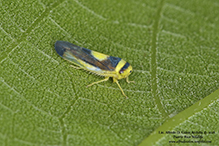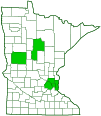saddleback leafhopper
(Colladonus clitellarius)
Conservation • Description • Habitat • Biology • Distribution • Taxonomy
Conservation Status |
|
|||||||
| IUCN Red List | not listed |
|||||||
| NatureServe | not listed |
|||||||
| Minnesota | not listed |
|||||||
Description |
||
Saddleback leafhopper is a medium-sized, easily recognized leafhopper. It is very common in the United States east of the Rocky Mountains and in adjacent Canadian provinces. It is a vector of eastern X-disease of peach. Adults are 3 ⁄16″ to ¼″ (5 to 6 mm) long. Females on average are ¼″ (5.70 mm) long, males a little smaller, 3 ⁄16″ (5.19 mm) long. The body is flattened laterally and tapered, appearing somewhat wedge-shaped from above. Coloration is variable. It is usually black to brown with mostly yellow and some ivory markings. Some individuals are light brown with mostly ivory markings. The underside is yellow. The head is about as wide as the exoskeletal plate covering the thorax (pronotum). The crown of the head, the only part visible when viewed from above, is ivory, rounded in front, slightly curved at the back, and widest at the middle. On the front margin there are two distinct, round, black spots. On the back margin there is a narrow black band. There are two large compound eyes and two tiny simple eyes (ocelli). The face, not visible from above, is yellowish-ivory. The antennae are short and bristle-like. The pronotum has a dark brown band at the base (behind the head) followed by a broad yellow or ivory band. It does not extend over the abdomen and the lateral margins are slightly curved. The plate between the wing bases (scutellum) is large, triangular, and dark brown to black. There are two pairs of wings, and they are held tent-like, almost vertically over the body when at rest. The forewings (hemelytra) are thickened, are longer than the body, and completely cover the sides of the body. The hemelytra are comprised of a narrow area (clavus) behind the scutellum when the hemelytra are closed; and the remaining, broad, marginal area (corium). There is a distinct yellow spot on the clavus that is widened near the front. The marginal area of the corium is transparent (hyaline). The hindwings are thin, membranous, a little shorter than the hemelytra, and concealed beneath the hemelytra. The legs entirely yellowish ivory. The last part of the leg (tarsus), corresponding to a foot, has three segments. |
||
Size |
||
Total length: 3 ⁄16″ to ¼″ (5 to 6 mm) Male: 3 ⁄16″ (5.19 mm) Female: ¼″ (5.70 mm) |
||
Similar Species |
||
| Leafhopper (Colladonus furculatus) is so similar to C. clitellarius that they can only be distinguished by examining the genitalia. Complicating matters, their ranges overlap in eastern and central United States. However, C. clitellarius is very common and C. furculatus is rare. C. furculatus has not been collected in Minnesota but it has been collected in Ontario, Wisconsin, and Iowa. | ||
Habitat |
||
Hardwood forests and forest edges |
||
Biology |
||
Season |
||
Two generations per year: May through September |
||
Behavior |
||
Adults are attracted to light. |
||
Life Cycle |
||
Eggs are laid in late June by first generation females, late August by the second. Eggs of the second generation overwinter. Eggs of the first generation hatch in about two weeks. |
||
Nymph Food |
||
|
||
Adult Food |
||
Plant juices from the leaves of many plants, especially willow, but also grape, wheat, chokecherry, lilac, poplar, goldenrod, boxelder, and honey locust. |
||
Distribution |
||||
|
Sources |
|||
| 1/22/2019 | ||||
Occurrence |
||||
Very common |
||||
Taxonomy |
|||
Order |
Hemiptera (true bugs, hoppers, aphids, and allies) | ||
Suborder |
Auchenorrhyncha (true hoppers) | ||
Infraorder |
Cicadomorpha (spittlebugs, cicadas, leafhoppers and treehoppers) | ||
Superfamily |
Membracoidea (leafhoppers and treehoppers) | ||
Family |
Cicadellidae (typical leafhoppers) | ||
Subfamily |
Deltocephalinae | ||
Tribe |
Athysanini | ||
| Subtribe | Platymetopiina | ||
Genus |
Colladonus | ||
Synonyms |
|||
Colladonus clitellaria |
|||
Common Names |
|||
saddled leafhopper |
|||
Glossary
Corium
The thickened basal portion of the front wing that lies between the clavus and the membrane of insects in the family Hemiptera. Plural: coria.
Hemelytron
The forewing of true bugs (Order Hemiptera), thickened at the base and membranous at the tip. Plural: hemelytra.
Ocellus
Simple eye; an eye with a single lens. Plural: ocelli.
Pronotum
The exoskeletal plate on the upper side of the first segment of the thorax of an insect.
Scutellum
The exoskeletal plate covering the rearward (posterior) part of the middle segment of the thorax in some insects. In Coleoptera, Hemiptera, and Homoptera, the dorsal, often triangular plate behind the pronotum and between the bases of the front wings. In Diptera, the exoskeletal plate between the abdomen and the thorax.
Tarsus
On insects, the last two to five subdivisions of the leg, attached to the tibia; the foot. On spiders, the last segment of the leg. Plural: tarsi.
Slideshows |
||

Slideshows |
||

Visitor Videos |
|||
Share your video of this insect. |
|||
| This button not working for you? Simply email us at info@MinnesotaSeasons.com. Attach a video, a YouTube link, or a cloud storage link. |
|||
Other Videos |
|||

Created: 1/23/2019
Last Updated:



